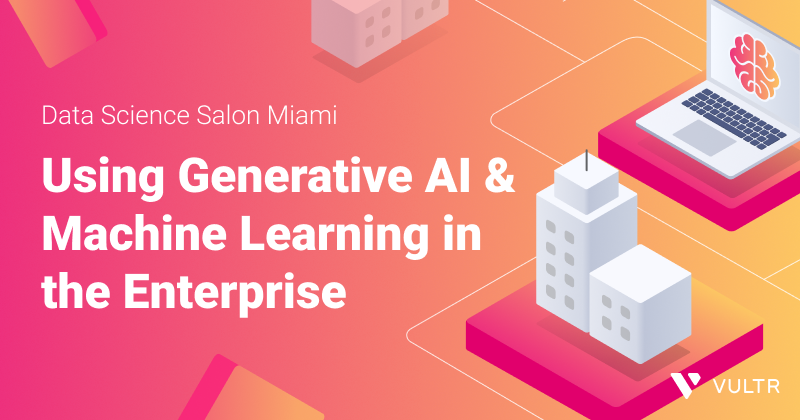Raising the Stakes for AI at Scale at Data Science Salon Miami
When we took part in the recent Data Science Salon Miami one-day conference in September, we knew our session "Scaling for Growth with an Enterprise Architecture for GenAI" would capture the attention of the data science leaders, practitioners, AI evangelists and all-around AI and machine learning enthusiasts in attendance. That’s because Data Science Salon has perfected the formulas for building vibrant data science and machine learning communities and orchestrating can’t-miss events throughout North America that bring these communities together to network and share the state of data science innovation and best practices.

When we took part in the recent Data Science Salon Miami one-day conference in September, we knew our session "Scaling for Growth with an Enterprise Architecture for GenAI" would capture the attention of the data science leaders, practitioners, AI evangelists and all-around AI and machine learning enthusiasts in attendance. That’s because Data Science Salon has perfected the formulas for building vibrant data science and machine learning communities and orchestrating can’t-miss events throughout North America that bring these communities together to network and share the state of data science innovation and best practices.
The theme of the Miami event was Using Generative AI and Machine Learning in the Enterprise, and the event drew a crowd of 350 individuals, including the data science heads of Royal Caribbean, VISA, Univision, PagerDuty, and other global enterprises. We discussed generative AI and how the technology will transform application portfolios to reinvent core business opportunities and reimagine customer experience. Amazingly, these are changes few could have conceived even one short year ago.
Several spoke about their company’s early successes with pilot projects. Their stories were fascinating, and each contributed to the palpable buzz in the room. When it was time for Vultr’s session, we went all-in and focused the group on thinking and acting in a future-forward manner beyond generative AI PoCs.
Operationalizing Generative AI across the Enterprise with GPU-Based Composable Cloud
Pilot programs are a reasonable and necessary step along the path to ROI on AI investments, but to fully get there, the journey must continue. The next step is to move beyond the vision and PoCs into true AI transformation by scaling AI across the enterprise. We discussed the importance of not looking at generative AI in a siloed fashion. Instead, we looked at building out generative AI in line with the MACH Alliance principles of composability. This flexible and open approach allows enterprises to grow their AI and ML initiatives without getting locked into specific infrastructure configurations that inhibit innovation. In this way, businesses can future-proof their AI, machine learning, and generative AI initiatives so that inference can be co-resident with app delivery to optimize performance with minimal latency.
We need to apply the lessons of previous generations of app development, deployment, and optimization and avoid the pitfalls that could impede generative AI deployments. At the event, we discussed the advantages and disadvantages of past generations of IT infrastructure and architecture, and we considered how and why they can or can’t support machine learning-driven cloud-native applications.
We also cautioned enterprises against purchasing their own GPUs and deploying them in their own data centers: If they take this legacy technology approach, they will miss out on all the advantages of a multicloud strategy developed and proven over the past two decades. Alternatively, by embracing a composable GPU cloud approach, generative AI models can deliver inferences in every enterprise's geo and ensure that technology limitations never hold back AI operations.
At Vultr, we’ve seen how our customers committed to composability can rapidly swap out stack components when other options become better suited to changing requirements, ensuring they always have the best cloud stack for their evolving business needs. A multicloud strategy enables businesses to use different cloud GPU clusters for various purposes. For example, model training and tuning can take place in one location, while inference happens in multiple locations. To illustrate, airport security cameras at Heathrow, Ben Gurion, and Charles de Gaulle deployed to perform facial recognition in real time can't send data back to a data center in Virginia. The lag time would mean that when a person of interest has been identified, they could be on a plane. That data needs to be processed locally to be of value.
Vultr Simplifies the GPU Deployment Process
We also discussed how organizations can speed time to productivity with a cloud GPU stack and how cloud GPUs mitigate the complexities of transitioning to GPUs and deploying AI across the enterprise. When even the most seasoned IT professionals try to deploy GPUs in on-prem data centers or private cloud environments, they tend to encounter configuration headaches that can become roadblocks to AI transformation. We explained how Vultr removes that complexity, making access to cloud GPUs a matter of clicks.
Looking Ahead
While 2023 exploded with generative AI, GPUs, and ML pilot projects, the coming years will see enterprises operationalize architectural models, core cloud-native engineering tools, and AI/ML best practices to deploy LLMs and generative AI applications faster, scale for growth, and produce dramatic ROI.
At Data Science Salon Miami, we started showing how enterprises can use composability to build and scale generative AI solutions. While there's no "one and done" button, Vultr offers ways to make the AI transformation journey shorter and more manageable. We will be there every step of the way to guide and support enterprises as they make that journey.
The potential for generative AI to transform enterprise operations is limitless, and we're here to help our customers keep the principles of composability firmly in mind. We're proud to lead the conversation now and look forward to where it takes you and us in the future. Contact our sales team to learn more.





































